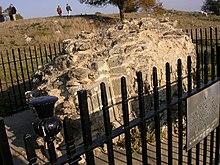Fotheringhay Castle

Fotheringhay Castle was a castle in Northamptonshire , England , and the ancestral seat of the Dukes of York .
It was probably founded around 1100 by Simon I de Senlis , the second Earl of Northampton . In 1113, ownership passed to Prince David of Scotland when he married Simon's widow, daughter of the first Earl of Northampton. The castle was then inherited from the Scottish princes until the early 13th century when it was conquered by King John of England . In 1220 the castle was administered by Ranulf de Blondeville , the sixth Earl of Chester. In January of the following year the castle was temporarily taken over by William de Forz in connection with his rebellion against King Henry III. taken. After Forz left the castle, it became Heinrich again. III. taken over and remained in royal hands until the reign of Edward II. It became the ancestral seat of the House of York . The English King Richard III. was born there in 1452, as was Margaret of York , a sister of his.
Mary Stuart was imprisoned in the castle for the last months of her life. After 18 years imprisonment in various English castles and palaces, she was released on February 8th . / February 18, 1587 greg. beheaded in the great hall . Contrary to the widespread allegation that Jacob I had the castle torn down in 1627 because his mother Maria was executed there, the property was probably abandoned and neglected because of its declining profitability. Despite the size and importance of the castle, it fell into disrepair during the Elizabethan era . Around 1635 , less than 50 years after Mary's execution, it was reported that the castle complex was in a ruinous state. The buildings were likely demolished soon afterwards.
The castle is a protected archaeological site ( Scheduled Monument ) of national importance and open to the public. Today there is little to see except for a few elevations and remains of walls. The complex offers a good view over the Nene Valley and the location makes its position as a fortress and defense system clear.
In the nearby church there are still tombstones and memorial plaques for numerous members of the York family, such as the dukes Edward († 1415) and Richard († 1460).
Building description
It is a large castle complex around which large ditches filled with water were dug. The castle had a polygonal stone fortress tower, the inner courtyard was protected by a wall and another moat. The outer bailey and grounds were fortified and the entrance to the gate was designed as a bridge over a lake. Little is known about the building history of the castle. Edmund Langley , son of King Edward III. , was the owner in the 14th century and is believed to have initiated the construction of the outer bailey and the construction of the eastern part of the moat.
Individual evidence
- ↑ northamptonshire.co.uk ( Memento of the original from April 14, 2009 in the Internet Archive ) Info: The archive link was automatically inserted and has not yet been checked. Please check the original and archive link according to the instructions and then remove this notice. .
Web links
Coordinates: 52 ° 31 '25 " N , 0 ° 26' 10" W.


